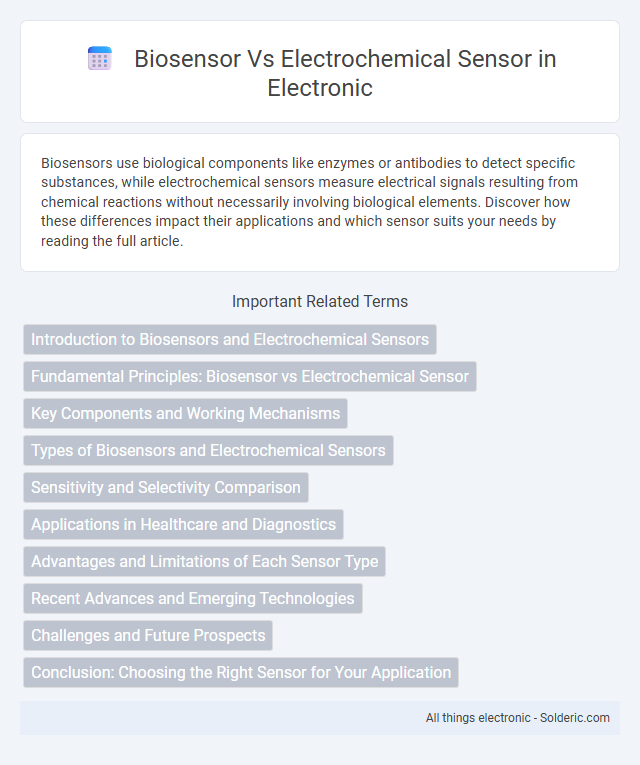Biosensors use biological components like enzymes or antibodies to detect specific substances, while electrochemical sensors measure electrical signals resulting from chemical reactions without necessarily involving biological elements. Discover how these differences impact their applications and which sensor suits your needs by reading the full article.
Comparison Table
| Feature | Biosensor | Electrochemical Sensor |
|---|---|---|
| Definition | Device combining biological elements with a transducer to detect analytes | Sensor that converts chemical information into an electrical signal |
| Components | Biological recognition element + transducer | Electrode system + chemical interface |
| Detection Principle | Biochemical interaction producing measurable signal | Electrochemical reactions (oxidation/reduction) |
| Applications | Medical diagnostics, environmental monitoring, food safety | Water quality, gas detection, industrial process control |
| Sensitivity | High, due to biological specificity | Moderate to high, depending on design |
| Selectivity | Highly selective for target biomolecules | Less selective, may require modification |
| Response Time | Seconds to minutes | Rapid, often seconds |
| Stability | Limited, affected by biological element degradation | Generally higher, based on electrode stability |
| Cost | Higher, due to biological components | Lower, simpler fabrication |
Introduction to Biosensors and Electrochemical Sensors
Biosensors are analytical devices that combine a biological recognition element with a transducer to detect specific analytes, offering high sensitivity and selectivity in medical diagnostics and environmental monitoring. Electrochemical sensors, a broad category within chemical sensors, measure electrical signals generated by chemical reactions, widely used for detecting ions, gases, and biomolecules. Your choice between biosensors and electrochemical sensors depends on the application's need for biological specificity versus general chemical detection.
Fundamental Principles: Biosensor vs Electrochemical Sensor
Biosensors utilize biological recognition elements such as enzymes, antibodies, or nucleic acids to detect specific analytes, generating a signal proportional to the target molecule concentration. Electrochemical sensors operate based on measuring electrical signals like current, voltage, or impedance changes resulting from redox reactions at the electrode interface. While all biosensors include a biological component linked to an electrochemical transducer, electrochemical sensors encompass a broader category that may or may not involve biological elements, focusing primarily on electrochemical phenomena for detection.
Key Components and Working Mechanisms
Biosensors typically consist of a bioreceptor, transducer, and signal processor, where the bioreceptor interacts selectively with the target analyte to produce a biochemical signal. Electrochemical sensors contain electrodes that measure electrical signals such as current, potential, or impedance changes resulting from analyte interaction. The key difference lies in biosensors' specificity through biological recognition elements, while electrochemical sensors rely primarily on electrochemical reactions for detection.
Types of Biosensors and Electrochemical Sensors
Biosensors include types such as enzymatic, immunosensors, and DNA biosensors, each designed to detect specific biological molecules with high sensitivity and selectivity. Electrochemical sensors, categorized into potentiometric, amperometric, and conductometric types, measure electrical signals resulting from chemical reactions at the sensor interface. Your choice between these depends on the target analyte and application requirements, as biosensors often combine biological recognition with electrochemical signal transduction for enhanced specificity.
Sensitivity and Selectivity Comparison
Biosensors typically offer higher selectivity compared to electrochemical sensors due to their use of biological recognition elements such as enzymes, antibodies, or nucleic acids that specifically bind to target analytes. Electrochemical sensors provide excellent sensitivity by detecting changes in electrical signals caused by chemical reactions but may suffer from interference from non-target substances. Your choice depends on whether you prioritize the precise identification of compounds (selectivity) or the detection of low concentrations (sensitivity) in complex samples.
Applications in Healthcare and Diagnostics
Biosensors and electrochemical sensors play crucial roles in healthcare and diagnostics by enabling rapid and accurate detection of biomolecules, pathogens, and metabolites. Biosensors, with biologically sensitive elements such as enzymes or antibodies, offer high specificity for monitoring glucose levels, detecting cancer markers, and identifying infectious diseases. Electrochemical sensors provide real-time, quantitative data in point-of-care testing, facilitating continuous monitoring of patient health and improving personalized treatment outcomes.
Advantages and Limitations of Each Sensor Type
Biosensors offer high specificity and sensitivity by incorporating biological recognition elements such as enzymes or antibodies, ideal for detecting complex biomolecules in medical diagnostics. Electrochemical sensors provide rapid, cost-effective measurements with straightforward signal transduction, making them suitable for environmental monitoring and industrial applications. Limitations of biosensors include potential instability of biological components and higher production costs, while electrochemical sensors may suffer from interference and lower selectivity without biorecognition elements.
Recent Advances and Emerging Technologies
Recent advances in biosensors have focused on integrating nanomaterials and biorecognition elements to enhance sensitivity and specificity for real-time diagnostics. Electrochemical sensors benefit from emerging technologies such as flexible electronics and microfluidic integration, enabling portable, low-cost detection of biochemical substances. Hybrid platforms combining biosensing capabilities with electrochemical transduction are driving innovation in personalized healthcare and environmental monitoring applications.
Challenges and Future Prospects
Biosensors face challenges including enzyme stability, sensitivity in complex biological matrices, and miniaturization for real-time monitoring, while electrochemical sensors often struggle with electrode fouling and selectivity in multi-analyte detection. Advances in nanomaterials, molecularly imprinted polymers, and integrated microfluidic systems offer promising improvements in specificity, durability, and portability for both sensor types. Future prospects highlight the convergence of biosensor and electrochemical sensor technologies into hybrid platforms, enabling highly sensitive, rapid, and multiparametric analysis for medical diagnostics, environmental monitoring, and food safety.
Conclusion: Choosing the Right Sensor for Your Application
Biosensors offer high specificity by using biological recognition elements, making them ideal for medical diagnostics and environmental monitoring where target selectivity is critical. Electrochemical sensors provide robust, cost-effective solutions with rapid response times suitable for industrial process control and continuous monitoring. Selecting the right sensor depends on balancing specificity, sensitivity, operational environment, and budget constraints to optimize performance for the intended application.
biosensor vs electrochemical sensor Infographic

 solderic.com
solderic.com